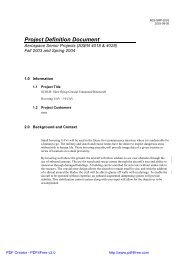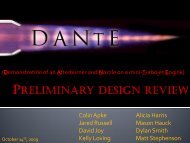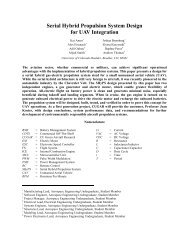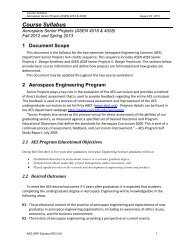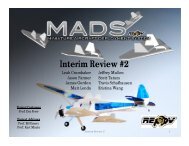PFR - Aerospace Engineering Sciences Senior Design Projects ...
PFR - Aerospace Engineering Sciences Senior Design Projects ...
PFR - Aerospace Engineering Sciences Senior Design Projects ...
You also want an ePaper? Increase the reach of your titles
YUMPU automatically turns print PDFs into web optimized ePapers that Google loves.
Project Final Report – CUDBF April 30 th , 2009<br />
ASEN 4028: <strong>Aerospace</strong> <strong>Senior</strong> <strong>Projects</strong><br />
The metal motor mounts were fabricated by printing out a template from SolidWorks © and then<br />
gluing the paper to thin aluminum sheeting. The shape was cut out using a bandsaw and the<br />
rough edges filed to prevent injury. Holes were then drilled into the metal in the appropriate<br />
places marked on the template. Once this was completed, the mounts were bent on a sheet metal<br />
bender.<br />
Given their unique shape, the main landing gear could not be purchased and thus had to be built<br />
from scratch. To begin construction, plywood mounts for the main gear were cut, the corners<br />
rounded, and blind nuts secured into the mounts to attach the main gear spars to the mounts.<br />
Al2024 spars were store-bought and the necessary bend locations marked along the spars. Each<br />
gear spar was bent by hand using a strong table mounted clamp and a hammer, making sure to<br />
bend the sections attached to the mount at a 90 degree angle, the longest sections at a 10 degree<br />
angle, and the section which holds the wheel at a 90 degree angle. Once the spar was bent, 1/8<br />
inch aluminum sheeting was cut into 1.5 inch long strips ¼ inches wide in order to secure the<br />
main gear strut to the plywood mount. The strips were then hammered over a piece of the<br />
aluminum spar to bend them into a horseshoe-like shape. Holes were then drilled into the strips,<br />
which were bolted into the blind nuts on the plywood mounts, securing the spars to the mounts.<br />
The main gear was then completed by attaching wheels and collars at the base of the spar.<br />
12.3 Wingtip Sub-Assembly<br />
Figure 108: Wingtip Interior Sub-Assembly<br />
While the interior and exterior sub-assemblies were being completed, other team members were<br />
beginning work on the aircraft wing. To begin fabricating the verticals, the main wing was first<br />
separated from the wingtip at the fold location using a hot wire cutter. After the cut was made,<br />
the aileron was removed. The aileron was then sheeted, sanded, and monokoted. Small holes<br />
were then drilled along the aileron leading edge and small hinges similar to those used in the<br />
rudder where glued into the aileron. The wingtip was then subjected to a series of hollows using<br />
a routing bit and a drill press. Holes were made for the wiring, balsa spar, and release<br />
mechanisms (to include the release mechanism mentioned above as well as the small metal plates<br />
that attract the magnets located in the wingtip stores and the servo). Once the holes were<br />
created, the release mechanisms were glued into place and balsa covers glued on top of the<br />
126




